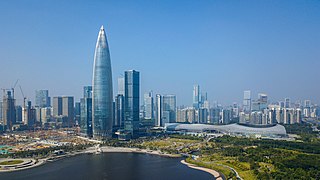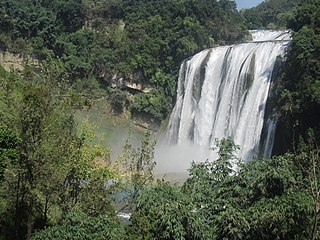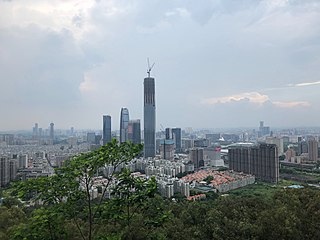Shimen National Forest Park is the largest forest park in Guangdong Province. [1] [2] [3]
Contents

Shimen National Forest Park is the largest forest park in Guangdong Province. [1] [2] [3]

Located in the Tsunghua District of Guangzhou City, Guangdong Province, with a total area of 2626.67 hectares and a forest coverage rate of 96.76%. It is 86 kilometers from Guangzhou city and 13 kilometers from the famous Tsunhua hot spring, bordered by the Nankun Mountain Nature Reserve to the east, and overlooks the Guangzhou Hydroelectric Storage Power Plant and Liushihe National Forest Park to the north. Located in the subtropical zone, the climate is warm all year round with an average annual temperature of 21.4 °C, an average maximum temperature of 28.5 °C from July to August and an average minimum temperature of 12.4 °C from January to February. [4]
Shimen Park was established on the basis of the state-owned Dalinshan Forest Farm, founded in 1960. In 1995, Shimen National Forest Park was established with the approval of the Ministry of Forestry, which is the first international forest bathing resort approved by the former Ministry of Forestry. [5]
There are mainly three categories of trees in the park: maple, sapium discolor, and Red Maple. [6]

Guangzhou, previously romanized as Canton or Kwangchow, is the capital and largest city of Guangdong province in southern China. Located on the Pearl River about 120 km (75 mi) northwest of Hong Kong and 145 km (90 mi) north of Macau, Guangzhou has a history of over 2,200 years and was a major terminus of the Silk Road.

Guangdong, previously romanized as Kwangtung or Canton, is a coastal province in South China, on the north shore of the South China Sea. The provincial capital is Guangzhou. With a population of 126.84 million across a total area of about 179,800 km2 (69,400 sq mi), Guangdong is China's most populous province and its 15th-largest by area, as well as the third-most populous country subdivision in the world.

Hunan is an inland province in Central China. Located in the middle reaches of the Yangtze watershed, it borders the province-level divisions of Hubei to the north, Jiangxi to the east, Guangdong and Guangxi to the south, and Guizhou and Chongqing to the northwest. Its capital and largest city is Changsha, which abuts the Xiang River. Hengyang, Zhuzhou, and Yueyang are among its most populous urban cities.

Guizhou is an inland province in Southwestern China. Its capital and largest city is Guiyang, in the center of the province. Guizhou borders the autonomous region of Guangxi to the south, Yunnan to the west, Sichuan to the northwest, the municipality of Chongqing to the north, and Hunan to the east. The Guizhou Province has a Humid subtropical climate. It covers a total area of 176,200 square kilometers and consists of six prefecture-level cities and three autonomous prefectures. The population of Guizhou stands at 38.5 million, ranking 18th among the provinces in China.

Zhongshan is a prefecture-level city in the south of the Pearl River Delta in Guangdong province, China. As of the 2020 census, the whole city with 4,418,060 inhabitants is now part of the Guangzhou–Shenzhen conurbation with 65,565,622 inhabitants. The city-core subdistricts used to be called Shiqi or Shekki.

Zhanjiang, historically spelled Tsamkong and previously known as Guangzhouwan, is a city in Guangdong province, China. The prefecture-level city of Zhanjiang administers the whole of Leizhou Peninsula, facing Haikou city of Hainan across the Qiongzhou Strait.

Dongguan is a prefecture-level city in central Guangdong Province, China. An important industrial city in the Pearl River Delta, Dongguan borders the provincial capital of Guangzhou to the north, Huizhou to the northeast, Shenzhen to the south, and the Pearl River to the west. It is part of the Pearl River Delta built-up area with more than 65.57 million inhabitants as of the 2020 census spread over nine municipalities across an area of 19,870 square kilometers (7,670 sq mi).

Zhaoqing, alternately romanized as Shiuhing, is a prefecture-level city in Guangdong Province, China. As of the 2020 census, its population was 4,113,594, with 1,553,109 living in the built-up area made of Duanzhou, Dinghu and Gaoyao. The prefectural seat—except the Seven Star Crags—is fairly flat, but thickly forested mountains lie just outside its limits. Numerous rice paddies and aquaculture ponds are found on the outskirts of the city. Sihui and the southern districts of the prefecture are considered part of the Pearl River Delta.

Shaoguan is a prefecture-level city in northern Guangdong Province (Yuebei), South China, bordering Hunan to the northwest and Jiangxi to the northeast. It is home to the mummified remains of the sixth Zen Buddhist patriarch Huineng. Its built-up area made up of Zhenjiang, Wujiang and Qujiang urban conurbated districts was home to 1,028,460 inhabitants as of the 2020 census.

Baiyun District is one of 11 urban districts of the prefecture-level city of Guangzhou, the capital of Guangdong Province, China. The district is located in the city's northern suburbs and is named after the Baiyun Mountain, one of the area's natural attractions.

Heyuan is a prefecture-level city of Guangdong province in the People's Republic of China. As of the 2020 census, its population was 2,837,686 whom 1,051,993 lived in the built-up area made of Yuancheng urban District and Dongyuan County largely being urbanized. Zijin County itself is quickly being conurbated in the agglomeration. The majority of the people are Hakka. The city includes many rainforests and the largest lake in Guangdong: Xinfengjiang Reservoir. The literal meaning of the city's name is "origin of the river". It has recently been officially titled as the "Hometown of the Dinosaur in China", due to the thousands of dinosaur egg fossils that have been unearthed in its vicinity.

Nan'ao or Nanao, formerly romanized Namoa, is an island and county of the prefecture-level city of Shantou in Guangdong Province, China. The county spans a land area of 114.74 square kilometres (44.30 sq mi), and sea area of 4,600 square kilometres (1,800 sq mi). As of 2020, the county had a permanent population of approximately 64,429.

Huangpu, alternately romanized as Whampoa, is one of 11 urban districts of the prefecture-level city of Guangzhou, the capital of Guangdong Province, China. Despite its name, it does not include Huangpu Island or its famous anchorage. Huangpu absorbed Guangzhou's former Luogang District in 2014. The district has been awarded the status of "Happiest District of China" in 2020.

Huadu District is one of 11 urban districts of the prefecture-level city of Guangzhou, the capital of Guangdong, China. It is located in the far northern suburbs of the city.

Guangming District is one of nine districts in the city of Shenzhen. The district, bordering the city of Dongguan in the Northwest of Shenzhen, was created in 2007 as a "functional area" of Bao'an District. In May 2018, it became a formal administrative division.

Qingcheng is a district of Qingyuan, Guangdong province, China.
Xuwen County is a county in the southwest of Guangdong Province, China. It is under the administration of Zhanjiang city.

Huangchuan County is a county of southeastern Henan province, People's Republic of China. It is located in the center of Xinyang City, straddling the Huang River.

The Guangdong–Hong Kong–Macao Greater Bay Area, commonly as the Greater Bay Area (GBA), is a megalopolis, consisting of nine cities and two special administrative regions in South China. It is envisioned by Chinese government planners as an integrated economic area aimed at taking a leading role globally by 2035.
Dashatou Railway Station, formerly known as Guangjiu Railway Station (广九站), was originally located at the southern end of Baiyun Road, Yuexiu District, Guangzhou, Guangdong Province, China. It was founded in 1911. It used to be the largest railway passenger station in Guangzhou. After the new Guangzhou passenger railway station opened in 1974, Dashatou railway station was once used as a passenger station but was demolished in 1985.